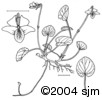
|
Northern Ontario Plant Database 
Plant DescriptionViola macloskeyi F.E.LloydEn: northern white violet, Macloskey’s violet, smooth white violet
Violaceae (Violet Family) General: A low perennial forb, spreading by thin runners (stolons), with smooth (glabrous) leaves and flower stalks (peduncles). See more information on the genus Viola at the end of this webpage. Nomenclatural Notes: Viola macloskeyi has been treated in the past as Viola pallens or Viola macloskeyi subsp. pallens, but these names have been reduced to synonymy within V. macloskeyi (see McKinney & Russell 2002). Leaves: Basal, simple, palmately-veined, smooth, long petiolate. Leaf blade ovate to nearly circular (orbicular) or kidney-shaped (reniform), 1–3 cm long during the flowering period, longer at maturity; the basal lobes cordate; apex of early leaves blunt (obtuse) to rounded; margins with low rounded teeth (crenate). Flowers: Bisexual, very fragrant, 0.7– 1 cm long. Sepals 5, linear-lanceolate; petals 5, white, the 2 lateral petals beardless, or occasionally with a few scattered hairs at the base of the petals, lower petal beardless, veined with purple. Flowers bloom in early spring. Fruit: A small ellipsoid capsule, green, smooth (glabrous), seeds blackish, 1.0–1.4 mm long. Fruits mature in summer. Habitat and Range: Low, wet habitats, especially alder thickets. Viola macloskeyi, native to temperate and boreal North America, is found throughout most of northern Ontario. Similar Species: In addition to the northern white violet, there are 3 other stemless white violets in northern Ontario. Of these, Viola lanceolata (lanceleaf violet) is easily identified, as it is the only violet with narrow, lanceolate to oblanceolate leaves. The remaining species all have cordate to reniform leaves; Viola blanda (sweet white violet) and Viola renifolia (kidneyleaf violet) can be differentiated from the northern white violet by the lack of stolons and the presence of hairs on at least the lower surface of their leaves. This webpage of Viola lanceolata from Connecticut Botanical Society. Another white violet, the primrose-leaf violet, Viola primulifolia, has long been considered a fertile hybrid of Viola macloskeyi and V. lanceolata, but recent publications (incl. McKinney & Russell 2002) treat it as a true species. The genus Viola - stemless white species Violaceae – Violet Family The typical violet has basal leaves that are simple and heart-shaped (cordate), but some violets have narrow, lanceolate leaves or divided leaves, and some species have tall or creeping stems that bear leaves along the length of the stem. Leaf margins are typically crenate, with rounded teeth. Flowers are solitary at the end of stalks (peduncles), with 5 green sepals and 5 purple, yellow, or white petals. The lower petal is spurred and often marked by purple veins. The 2 lateral petals may also have a few purple veins. Some or all of the petals may be bearded. The anthers of the 5 stamens surround the style of the pistil. The 3-carpelled ovary develops into a capsule that splits into 3 boat-shaped segments. The smooth seeds are expelled from the matures capsule as the sides of the capsule wall in each segment press together from the base upward, forcibly squeezing the seeds out of the fruit. Violets also bear small, self-pollinating (cleistogamous) flowers, which lack petals and do not open; these flowers fertilize and set fruit while still in bud. There are 14 native species of violets (Viola) in northern Ontario. Although often regarded as a difficult group to identify, many former species have recently been combined, making identification much easier. The most important characters to note when trying to identify violets are: – the number of bearded petals (0–5) – the shape of the beard hairs (straight or swollen at the tips) – the presence or absence of hairs along the margins of the sepals (ciliate or entire) – the length of the spur on the lower petal (short or long spurred) – the presence or absence of hairs on the upper or lower leaf surfaces and flower stalks – the presence or absence of stolons – slender runners that spread just below the surface. Violets can be divided into 4 main groups, based on flower colour and presence or absence of above-ground stems:
A key to the stemless white violets is provided below, followed by a chart that compares the traits of each of the stemless white violet species.
|
||||||||||||||||||||||||||||||||||||||||||||||||||||||||||||||||||||||||||||||||||||||











